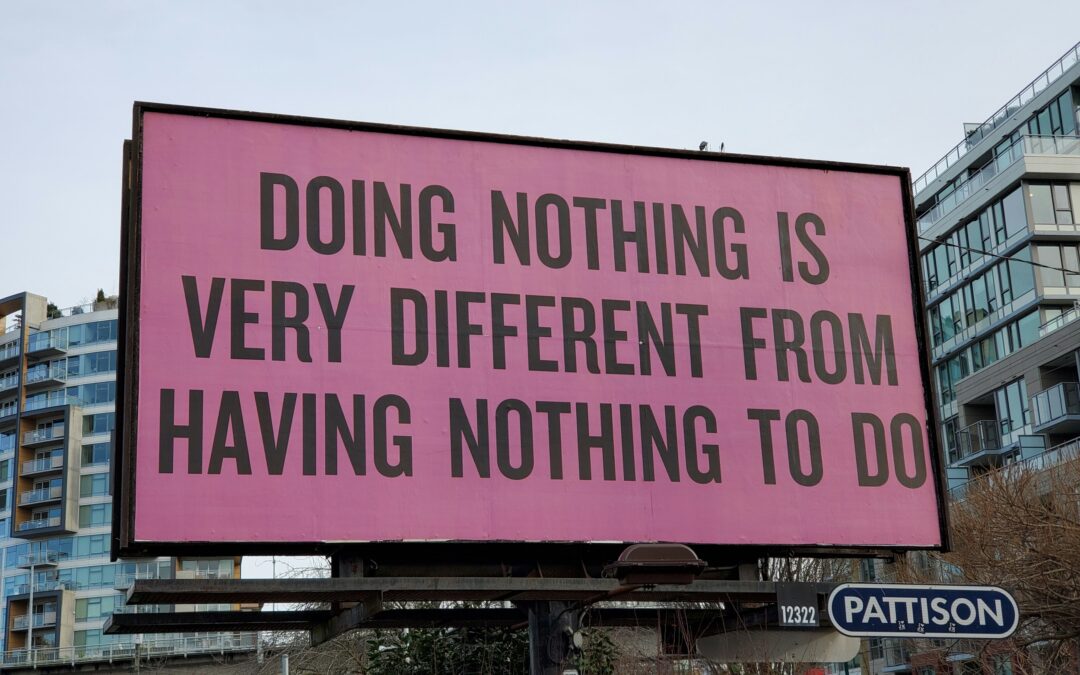
by Robyn Bolton | Jun 25, 2025 | Leadership, Stories & Examples, Strategy
Convinced that Strategic Foresight shows you a path through uncertainty? Great! Just don’t rush off, hire futurists, run some workshops, and start churning out glossy reports.
Activity is not achievement.
Learning from those who have achieved, however, is an excellent first activity. Following are the stories of two very different companies from different industries and eras that pursued Strategic Foresight differently yet succeeded because they tied foresight to the P&L.
Shell: From Laggard to Leader, One Decision at a Time
It’s hard to imagine Shell wasn’t always dominant, but back in the 1960s, it struggled to compete. Tired of being blindsided by competitors and external events, they sought an edge.
It took multiple attempts and more than 10 years to find it.
In 1959, Shell set up their Group Planning department, but its reliance on simple extrapolations of past trends to predict the future only perpetuated the status quo.
In 1965, Shell introduced the Unified Planning Machinery, a computerized forecasting tool to predict cash flow based on current results and forecasted changes in oil consumption. But this approach was abandoned because executives feared “that it would suppress discussion rather than encourage debate on differing perspectives.”
Then, in 1967, in a small 18th-floor office in London, a new approach to ongoing planning began. Unlike past attempts, the goal was not to predict the future. It was to “modify the mental model of decision-makers faced with an uncertain future.”
Within a few years, their success was obvious. Shell executives stopped treating scenarios as interesting intellectual exercises and started using them to stress-test actual capital allocation decisions.
This doesn’t mean they wholeheartedly embraced or even believed the scenarios. In fact, when scenarios suggested that oil prices could spike dramatically, most executives thought it was far-fetched. Yet Shell leadership used those scenarios to restructure their entire portfolio around different types of oil and to develop new capabilities.
The result? When the 1973 oil crisis hit and oil prices quadrupled from $2.90 to $11.65 per barrel, Shell was the only major oil company ready. While competitors scrambled and lost billions, Shell turned the crisis into “big profits.”
Disney: From Missed Growth Goals to Unprecedented Growth
In 2012, Walt Disney International’s (WDI) aggressive growth targets collided with a challenging global labor market, and traditional HR approaches weren’t cutting it.
Andy Bird, Chairman of Walt Disney International, emphasized the criticality of the situation when he said, “The actions we make today are going to make an impact 10 to 20 years down the road.”
So, faced with an unprecedented challenge, the team pursued an unprecedented solution: they built a Strategic Foresight capability.
WDI trained over 500 leaders across 45 countries, representing five percent of its workforce, in Strategic Foresight. More importantly, Disney integrated strategic foresight directly into their strategic planning and performance management processes, ensuring insights drove business decisions rather than gathering dust in reports.
For example, foresight teams identified that traditional media consumption was fracturing (remember, this was 2012) and that consumers wanted more control over when and how they consumed content. This insight directly shaped Disney+’s development.
The results speak volumes. While traditional media companies struggled with streaming disruption, Disney+ reached 100 million subscribers in just 16 months.
Two Paths. One Result.
Shell and Disney integrated Strategic Foresight differently – the former as a tool to make high-stakes individual decisions, the latter as an organizational capability to affect daily decisions and culture.
What they have in common is that they made tomorrow’s possibilities accountable to today’s decisions. They did this not by treating strategic foresight as prediction, but as preparation for competitive advantage.
Ready to turn these insights into action? Next week, we’ll dive into the tools in the Strategic Foresight toolbox and how you and your team can use them to develop strategic foresight that drives informed decisions.

by Robyn Bolton | Jun 17, 2025 | Leadership, Strategy
Are you spooked by the uncertainty and volatility that defines not just our businesses but our everyday lives? Have you hunkered down, stayed the course, and hoped that this too shall pass? Are you starting to worry that this approach can’t go on forever but unsure of what to do next? CONGRATULATIONS, consultants have heard your cries and are rolling out a shiny new framework promising to solve everything: Strategic Foresight.
Strategic foresight is the latest silver bullet for navigating our chaotic, unpredictable world.
Remember in 2016 when Agility was going to save us all? Good times.
As much as I love rolling my eyes at the latest magic framework, I have to be honest – Strategic Foresight can live up to the hype. If you do it right.
What Strategic Foresight Actually Is (Spoiler: Not a Silver Bullet)
A LOT is being published about Strategic Foresight (I received 7 newsletters on the topic last week) and everyone has their own spin. So let’s cut through the hype and get back to basics
What it is: Strategic foresight is the systematic exploration of multiple possible futures to anticipate opportunities and risks, enabling informed decisions today to capture advantages tomorrow.
There’s a lot there so let’s break it down:
- Systematic exploration: This isn’t guessing, predicting, or opining. This is a rigorous and structured approach
- Multiple possible futures: Examines multiple scenarios because we can’t possibly forecast or predict the one future that will occur
- Enabling informed decisions today: This isn’t an academic exercise you revisit once a year. It informs and guides decisions and actions this year.
- Capture advantages tomorrow: Positions you to respond to change with confidence and beat your competition to the punch
How it fits: Strategic Foresight doesn’t replace what you’re doing. It informs and drives it.
| Approach |
Timeline |
Focus |
| Strategic Foresight |
5-20+ years |
Explore possible futures |
| Strategic Planning |
3-5 years |
Create competitive advantage |
| Business Planning |
Annual cycles |
Execute specific actions |
The sequence matters: Foresight → Strategic Planning → Business Planning.
This sequence also explains why Strategic Foresight is so hot right now. Systemic change used to take years, even decades, to unfold. As a result, you could look out 3-5 years, anticipate what would be next, and you would probably be right.
Now, systemic change can happen overnight and be undone by noon the next day. Whatever you think will happen will probably be wrong and in ways you can’t anticipate, let alone plan for and execute against.
Strategic Foresight’s rigorous, multi-input approach gives us the illusion of control in a world that seems to be spinning out of it.
How to Avoid the Illusion and Get the Results.
Personally, I love the illusion of control BUT as a business practice, I don’t recommend it.
Strategic Foresight’s benefits will stay an illustion if you don’t:
- Develop in-house strategic foresight capabilities. Amy Webb’s research at NYU shows that companies using rigorous foresight methodologies consistently outperform those stuck in reactive mode. Shell’s legendary scenario planning helped them navigate oil crises while competitors flailed. Disney’s Natural Foresight® Framework keeps them ahead of entertainment trends that blindside others.
- Integrate foresight into your annual strategic planning cycle: Strategic foresight is a front-end effort that makes your 3-5 year strategy more robust. If you treat it like a separate exercise where you hire futurists, and run some workshops, and check the Strategic Foresight box, you won’t see any benefits or results.
What’s Next?
Strategic foresight isn’t a silver bullet, but it can be a path through uncertainty to advantage and growth.
The difference between success and failure comes down to execution. Do you treat it as prediction or preparation? Do you integrate it with existing planning or silo it in innovation labs?
Ready to separate the hype from the hard results? Our next post shows you what two industry leaders learned about turning foresight into competitive advantage and how you can use those lessons to your benefit

by Robyn Bolton | Jun 10, 2025 | Customer Centricity, Leadership
The data speaks for itself: Your employees don’t believe you practice customer-first leadership.
According to Gallup’s research, only one in five of your people think you make decisions with customers in mind. That means four out of five watch you say one thing and do another. Every. Single. Day.
And it’s getting worse. Fewer than three in ten of your employees feel proud of what they’re building for your customers. As a result, employee pride in what they create and deliver is at an all-time low.
You know what this means, don’t you? Your customer-first messaging isn’t inspiring anyone—it’s insulting them. Because they see the truth behind your town hall speeches, and the truth is that customers aren’t first.
How Are We Still Screwing This Up?
Customer-centricity has been business gospel for decades. We’ve got libraries full of case studies, armies of consultants, and enough “customer first” wall art to wallpaper the Apple HQ. So, how the hell are we getting worse at this?
Because most leaders treat customer focus like a box to check. They say the right words in town halls and analyst calls but make decisions that prioritize quarterly numbers, internal politics, and whatever shiny new idea they come up with.
Leaders say customers come first, then cut support staff to hit margins. They preach customer obsession, then ignore feedback that requires real change. They commission expensive customer journey maps, then never look at them again.
Employees see it all.
And when employees stop believing in what they deliver, customers know it immediately. Every burned-out support call, every half-hearted sales pitch, every policy that punishes the customer to boost the company’s profit.
You CAN do better
You only need to look as far as the telecom industry (?!?!?!) for an $800 million example.
In 2005, Arlene Harris co-founded GreatCall (now Lively) and did something radical: she built a company based on the Jobs to be Done of senior citizens. While everyone else chased flashy features for younger markets, she recognized that older Americans didn’t want a smartphone—they wanted a lifeline.
Harris delivered with the Jitterbug, a simple flip phone with giant buttons. But that was just the beginning. Focusing more on helping customers stay safe and connected than cool features for the tech geeks, she quickly built an ecosystem offering emergency response, health monitoring, 24/7 human support, and caregiver connectivity.
When Best Buy acquired GreatCall for $800 million in 2018, they weren’t buying a phone company. They were buying something rare: a trusted, high-value services company with intensely loyal customers.
Harris succeeded by doing precisely what the data shows most leaders aren’t doing: genuinely understanding and serving real customer needs.
WILL you do better?
Customer-first leadership isn’t a box to check. It’s basic leadership integrity. It’s the difference between meaning what you say and just saying what sounds good.
When four out of five of your employees don’t trust your customer commitment, the problem isn’t your strategy deck, digital transformation, or tariffs. The problem is you.
So here’s your moment of truth: When was the last time you listened to customer service calls? Not the sanitized highlights your team shows you—the raw, unfiltered frustration of someone who can’t get help. When did you last sit in a waiting room and watch how people navigate your system? Or stock a shelf and see what customers actually do?
If you can’t remember, that’s your answer. If you’ve never done it, that’s worse.
The question is: Will you keep performing customer-centricity, or start practicing it?

by Robyn Bolton | May 30, 2025 | Leadership, Strategy
Conventional wisdom tells us that transformation flows from the C-suite down because real change requires executive mandates and company-wide rollouts. But what if our focus on building transformation momentum is exactly backward?
Ever since reading Multipliers, where Liz Wiseman revealed how the best leaders amplify their people rather than diminish them, I’ve wondered if, like innovation, organizational transformation and change also require us to do the opposite of our instincts.
I recently had the opportunity to dig deeper into this topic with her, and I couldn’t resist exploring how change really happens in large organizations.
What emerged wasn’t another framework—it was something more brilliant and subversive: how middle managers quietly become change agents, why sustainable transformation looks nothing like a launch event, and the liberating truth that leaders don’t need to be perfect.
Robyn Bolton: What’s the one piece of conventional wisdom about leading change that you believe organizations need to unlearn?
Lize Wiseman: I don’t believe that change needs to start, or even be sponsored, at the top of the organization. I’ve seen so much change led from the middle management ranks. When middle managers experiment with new mindsets and practices inside their organizations, they produce pockets of success—anomalies that catch the attention of senior executives and corporate staffers who are highly adept at detecting variances (both negative and positive). When senior executives notice positive outcomes, they are quick to elevate and endorse the new practices, in turn spreading the practices to other parts of the organization. In other words, most senior executives are adept at spotting a parade and getting in front of it! (Incidentally, this is one of several executive skills you won’t find documented on any official leadership competency model.) If you don’t yet have the political capital to lead a company-wide initiative, run a pilot with a few rising middle managers. Shine a spotlight on their success and let the practices spread to their peers. Expose their good work to the executive team and make yourself available to turn the parade into a movement.
RB: In your research and work, what’s the most surprising pattern you’ve observed about successful organizational transformation?”
LW: As mentioned above, I believe the starting point for transformation is less important than how you will sustain the momentum you’ve generated. Unfortunately, most new initiatives—be they corporate change initiatives or personal improvement plans—begin with a bang but fizzle out in what I call “the failure to launch” cycle. Transformation that is sustained over time usually starts small and builds a series of successive wins. Each win provides the energy needed to carry the work into the next phase. These series of wins generate the energy and collective will needed to complete the cycle of success. As that cycle spins, nascent beliefs become more deeply entrenched and old survival strategies get supplanted by new methods to not just survive but thrive inside the organization.
Each little success requires careful support and an evidence-backed PR campaign to build awareness and broad support for the new direction. Nascent behavior and beliefs are fragile and will be overpowered by older assumptions until they are strengthened by supporting evidence. The supporting evidence forms a buttress around the budding mindset or practices, much like a brace around a sapling provides stability until the tree is strong enough to stand on its own.
RB: How has your thinking about what makes an effective leader evolved over the course of your career?
LW: When I began researching good leadership, most diminishing leaders appeared to be tyrannical, narcissistic bullies. But as I further studied the problem, I’ve come to see that the vast majority of the diminishing happening inside our workplaces is done with the best of intentions, by what I call the Accidental Diminisher—good people trying to be good managers. I’ve become less interested in knowing who is a Diminisher and much more interested in understanding what provokes the Diminisher tendencies that lurk inside each of us.
RB: When you consider all the organizations you’ve studied, what’s the most powerful lesson about driving meaningful change that most leaders overlook?
LW: One of the dangers of trying to lead change from the top is that most leaders have a hard time being a constant role model for the changes they advocate for. Even the best leaders can’t always display the positive behaviors they espouse and ask their organizations to embody. It’s human to slip up. But when behavior change is led primarily from the top, these all-too-natural slip-ups can become major setbacks for the whole organization because they provide visible evidence that the new behavior isn’t required or feasible, and followers can easily give up. Wise leaders understand this dynamic and build a hypocrisy factor into their change plans–meaning, they acknowledge upfront that they aspire to the new behavior but don’t always fully embody it, yet. They set the expectation that there will be setbacks and invite people to help them be better leaders as well. They acknowledge that the route to new behavior typically looks like the acclimation process used by high-elevation climbers. These climbers spend some of their days in ascent, but once they reach new elevations, often have to descend to lower camps to acclimate. It’s the proverbial two-steps-forward, one-step-back process. When leaders acknowledge their shortcomings and the likelihood of their future missteps, they not only minimize the chance that others give up when they see hypocrisy above them, but they create space for others to make and recover from their own mistakes.
RB: Looking ahead, what do you believe is the most important capability leaders need to develop to help their organizations thrive?
LW: Leading in uncertainty, specifically the ability to lead people to destinations that they themselves have never been.
I love that Liz’s insights flip the script, calling on people outside the C-Suite to stop waiting for permission and start running quiet experiments, building proof points, and letting success do the selling.
The next time you want a change or have change thrust upon you, don’t look for a parade to lead. Look for one person willing to try something different and get to work.

by Robyn Bolton | May 27, 2025 | Innovation, Leadership, Strategy
On May 6, Nvidia CEO Jensen Huang and ServiceNow CEO Bill McDermott joined CNBC’s “Power Lunch” to discuss the companies’ partnership. But something that Huang said about large-scale cloud service providers (i.e., hyperscalers) at the end of the interview stopped me in my tracks:
It’s not a data center that stores information. It’s a factory that produces intelligence. And these intelligence tokens could be reformulated into music, images, words, avatars, recommendations of music, movies, or, you know, supply chain optimization techniques.
What struck me wasn’t the claim about what data centers and AI could create—we’ve seen evidence of that already. It was the reframing of data centers from storage solutions to “intelligence factories.”
When leaders fail to lead, or even recognize that the business they’re in is different, even the best efforts at business transformation are doomed.
Because reframing is how Disruption begins.
Data Centers Are No Longer in the Data Business
Repositioning your company to serve a new job requires rethinking, redesigning, and rebuilding everything.
Consider the old adage that railroads failed because they thought they were in the railroad business. By defining themselves by their offering (railroad transportation) rather than the Jobs to be Done they solve (move people and cargo from A to B), railroads struggled to adapt as automobiles became common and infrastructure investments shifted from railroads to highways.
Data centers have similarly defined themselves by their offering (data storage). However, Huang’s reframing signals a critical shift in thinking about the Jobs that data centers solve: “provide intelligence when I need it” and “create X using this intelligence.”
Intelligence Factories Require a New Business Model
This shift—from providing infrastructure for storing data to producing intelligence, strategic analysis, and creative output—will impact business models dramatically.
Current pricing models based on power consumption or physical space will fail to capture the full value created. Capabilities mustexpand beyond building infrastructure to include machine learning and AI partnerships.
But Intelligence Factories are Just the Beginning
While Intelligence Factories will require data centers to rethink their business models and may even introduce a new basis of competition (a requirement for Disruption), they’re only a stepping-stone to something far more disruptive: Dream Factories.
While the term “Dream Factory” was coined to describe movie studios during Golden Era, the phrase is starting to be used to describe the next iteration of data centers and AI. Today’s AI is limited to existing data and machine learning capabilities, but we’re approaching the day when it can create wholly new music, images, words, avatars, recommendations, and optimization techniques.
This Is Happening to Your Business, Too
This progression will transform industries far beyond technology. Here’s what the evolution from data storage to Intelligence Factory to Dream Factory could look like for you:
- Healthcare: From storing medical records to diagnosing conditions to creating novel treatments
- Financial Services: From tracking transactions to predicting market movements to designing new financial instruments
- Manufacturing: From inventory management to process optimization to inventing new materials
- Retail: From cataloging products to personalizing recommendations to generating products that don’t yet exist
How to prepare for your Dream Factory Era
Ask yourself and your team these 3 questions:
- Is my company defining itself by what it produces today or by the evolving needs it serves?
- What is our industry’s version of the shift from data storage to dream factory?
- What happens to our competitive advantage if someone else creates our industry’s dream factory before we do?
If you’re serious about transformation, take a cue from the data centers: redefine what business you’re in—before someone else does.
After all, the key to success isn’t trying to stay a data center. It’s recognizing you’ve become an intelligence factory, and your long-term success depends on becoming a dream factory.

by Robyn Bolton | May 21, 2025 | Innovation, Leadership, Tips, Tricks, & Tools
“What will you do on vacation?” a colleague asked.
“Nothing,” I replied.
The uncomfortable silence that followed spoke volumes. In boardrooms and during quarterly reviews, we celebrate constant motion and back-to-back calendars. Yet, study after study shows that the most successful leaders embrace a counterintuitive edge: strategic idleness.
While your competitors exhaust themselves in perpetual busyness, research shows that deliberate mental downtime activates the brain networks responsible for strategic foresight, innovative solutions, and clear decision-making.
The Status Trap of Busy-ness
At one company I worked with, there was only one acceptable answer to “How are you doing?” “Busy.” The answer wasn’t a way to avoid an awkward hallway conversation. It was social currency. If you’re busy, you’re valuable. If you’re fine, you’re expendable.
A 2017 study published in the Journal of Consumer Research confirmed what Columbia, Georgetown, and Harvard researchers discovered: being busy is now a status symbol, signaling “competence, ambition, and scarcity in the market.”
But here’s the uncomfortable truth: your packed schedule is undermining the very outcomes you’re accountable for delivering.
Your Brain’s Innovation Engine
Neuroscience has confirmed what innovators have long practiced: Strategic Idleness. While you consciously “do nothing,” your default mode network (DMN) engages, making unexpected connections across stored information and experiences.
Recent research published in the journal Brain demonstrates that the DMN is activated during creative thinking, with a specific pattern of neural activity occurring during the search for novel ideas. This network is essential for both spontaneous thought and divergent thinking, core elements of innovation.
So if you’ve always wondered why you get your best ideas in the shower, it’s because your DMN is powered all the way up.
Three Ways to Power-Up Your Engine
Here are three executive-grade approaches to strategic idleness without more showers or productivity sacrifices:
- Pause for 10 Minutes Before Making a Decision
Before making high-stakes decisions, implement a mandatory 10-minute idleness period. No email, no conversation—just sitting. Research on cognitive recovery suggests that this brief reset activates your DMN, allowing for a more comprehensive consideration of variables and strategic implications.
- Take a Walking Meeting with Yourself
Block 20 minutes in your calendar each week for a solo walking meeting (and then take the walk!). No other attendees, no agenda, just walking. Researchers at Stanford University found that walking increases creative output by an average of 60% compared to sitting. The combination of physical movement and mental space creates ideal conditions for your brain to generate solutions to problems you didn’t know you had.
- Schedule 3-5 minutes of Strategic Silence before key discussions
Research on group dynamics shows that silent reflection before discussion can reduce groupthink and increase the quality of ideas by helping team members process information more deeply. Before you dive into a critical topic at your next leadership meeting, schedule 3-5 minutes of silence. Explain that this silence is for individual reflection and planning for the upcoming discussion, not for checking email or taking bathroom breaks. Acknowledge that it will feel awkward, but that it’s critical for the upcoming discussion and decision.
Remember, You’re Not Doing Nothing If You’re being Strategically Idle
The most valuable asset in your organization isn’t technology, capital, or even the products you sell. It’s the quality of thinking that goes into critical decisions. Strategic idleness isn’t inaction; it’s the deliberate cultivation of conditions that foster innovation, clear judgment, and strategic foresight.
While your competitors remain trapped in perpetual busyness, by using executive advantage of strategic idleness, your next breakthrough will present itself.
This is an updated version of the June 9, 2019, post, “Do More Nothing.”





